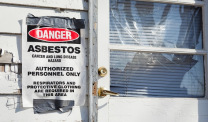Does Asbestos Accumulate in the Food Chain?
Awareness & ResearchWritten by Daniel King | Edited By Walter Pacheco

Bioaccumulation is a hazard with many toxic substances, but not so much with asbestos.
Certain dangerous chemicals can make their way up the food chain and ultimately threaten human health.
Fortunately, living things cannot absorb asbestos particles the way they can absorb DDT or mercury. But many asbestos-exposure risks remain within the man-made environment.
Bioaccumulation is when chemicals build up inside animals’ bodies. Toxic accumulation is a major problem in animals high up in the food chain. For example, large fish often end up with all the toxic substances the animals and plants lower in the food chain absorbed from the environment.
This makes it dangerous to eat fish from polluted lakes and rivers. People should also limit how often they eat large ocean fish such as tuna.
The toxic substances that accumulate in the food chain are called persistent chemicals. These chemicals do not naturally break down over time. Hazardous persistent chemicals include PCBs, DDT, dioxins and mercury.
Asbestos does not break down over time, and it can accumulate in an animal’s body. But asbestos generally does not threaten food chains because it accumulates in a different way.
Asbestos vs. Other Persistent Chemicals
Chemicals such as DDT and mercury can be absorbed into the fat in plants, animals and people. Asbestos is different — living things do not absorb it on a chemical level.
Rather, asbestos fibers are like microscopic needles that get stuck in the body’s tissues, especially in and around the lungs.
Asbestos exposure primarily happens when people breathe in asbestos dust.
The risk of asbestos exposure through the food chain is low, because plants do not absorb asbestos. Animals may inhale or swallow asbestos dust, but asbestos generally does not accumulate in muscle or fat.
Eating meat from an asbestos-exposed animal is unlikely to pass on the asbestos exposure.
Historically, most asbestos exposure has happened on the job. Thousands of retired tradesmen and veterans now suffer from mesothelioma and other diseases as a result.
Asbestos Exposure Dangers
Today, the greatest risk of asbestos exposure in the U.S. comes from disturbing construction and insulation materials that date back to before the 1980s.
Certain car parts and talc products manufactured overseas may also contain asbestos.
Asbestos was ubiquitous in construction and heavy industry for much of the 20th century. Almost all buildings were constructed with asbestos products before the health risks came to light.
Asbestos insulation was especially common around high-temperature equipment in factories, refineries, power plants and ships.
Old, crumbling asbestos materials can easily release toxic dust when disturbed, and it is dangerous to use power tools on any kind of asbestos material.
The job of sealing or removing asbestos-containing materials should be left to qualified asbestos-abatement professionals.






